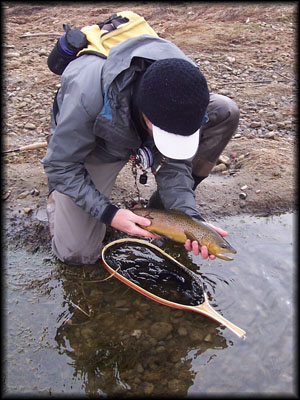
Photography || Portfolio Site || Blog || About || Contact || Home ||
Do not disturb? A look at fishing to spawning trout
Published in the Sept/Oct 2008 issue of the Montana Sporting Journal
By Joshua Bergan
BEAVERHEAD RIVER, Mont. - Conscientious anglers know to avoid stepping on redds, but what about pursuing spawning trout?
It’s one of fly fishing’s most debated (and lectured about) ethical discussions, and while likely the most commonly held opinion is that anglers should let them be, not everyone abides.

Some wonder why anglers feel the need to harass fish at that stage, when we live in a state with so many other fishing opportunities, while others feel that, as long as it’s within the law, there’s nothing wrong with it.
So what exactly are the effects of hooking, battling, and landing a spawning trout?
Montana Fish Wildlife and Parks Fisheries Biologist Ron Spoon offered his expertise: “My experience with brown trout spawning in the Missouri River is that it takes more than one day (sometimes three days) for a female to complete egg deposition in the redd. Once she starts this process of digging, laying eggs, covering the first egg pocket with gravel, and repeating the steps two to four times, it intuitively makes sense that interrupting the difficult process has potential impacts. Eggs are loose at this stage of the game and simply expelling eggs during the angling process has obvious negative consequences.”
Spoon also points out that trout spawning in tributaries can be concentrated, and can be on the only redds available to populate a 10-mile stretch of river. If anglers pound those redds, trout populations over the entire 10-mile stretch can be decimated for years.
Other possible consequences:
• Pulling a hen off the redd leaves the eggs open to predation
• Some believe the mortality rate of released spawning fish is higher than non-spawning fish because the trout are naturally exhausted by the act of spawning
• Even with the normal mortality rate for released fish (somewhere between 5 and 10 percent), that that percentage of next year’s crop is taken right off the top, since no parent is present to take care of the eggs. Not only that, but 5 years down the road, that loss will have grown exponentially as an entire family tree, which could result in millions of fish, was stumped.
Spoon pointed out that another consideration is the “fair chase” aspect. Anyone who’s ever tried to catch a spawning trout can attest to the fact that it’s not exactly spring-creek fishing. The spawners act like hatchery fish at feeding time, so it’s not generally considered as sporting to pursue them.
“If you make 10 casts and catch or snag at least five spawning adults, you probably sense that you should exercise moderation,” Spoon said. “Alternatively, when large numbers of trout begin to stage at the Missouri River delta on the south end of Canyon Ferry Lake, ice fisherman begin to double or triple their catch rates in a large lake and virtually everyone considers this situation to simply be improved fishing opportunity.”
While this author can reserve judgement on fishing to spawning rainbows and browns, fishing to spawning native cutthroats (and certainly fluvial grayling) is a different story. Whirling disease, the hybridization of rainbows and cutts (which diminishes genetically pure strains of cutthroat trout), and competition from introduced fish already handicap these species. There is no excuse for disturbing Montana’s state fish’s spawning when their existence is on the cusp.
Spoon offered this as an alternative: “When you find fish spawning on shallow riffles, it is generally a better idea to enjoy watching the process of the female on her side digging a depression, males chasing each other, eggs being fertilized in moving water without being washed downstream, and eggs being covered with 2 or 3 inches of gravel. Some may find that watching the process is as enjoyable as the fishing. Perhaps most importantly, do not step on these areas of clean gravel because eggs are easily crushed.”
All of that said, as long as it’s legal, you can’t get in any real trouble. And one would hope that if catching spawners affected any fishery to the point where it was detrimental, Montana FWP would close that water. One of the agency’s primary responsibilities is to maintain healthy fisheries. For the record, many spawning areas are subject to seasonal closure.
By October, anglers will be presented with spawning brown trout and the decision of whether or not to fish to them.
Author and editor Ty Stockton offers this perspective in his recently released Big Game Hunter’s Guide to Wyoming: “When ethical considerations are more restrictive than local laws, follow the ethical guidelines. Every hunter (in this case, angler) is an ambassador for the sport; do your part to show that (anglers) are fair, ethical, and honest, and that conservation is our first priority.”
The decision of what exactly is ‘ethical’, is yours.